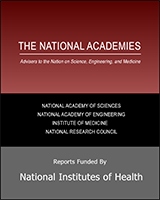NCBI Bookshelf. A service of the National Library of Medicine, National Institutes of Health.
Excerpt
Research in proteomics is the next logical step after genomics in understanding life processes at the molecular level. In the largest sense proteomics encompasses knowledge of the structure, function and expression of all proteins in the biochemical or biological contexts of all organisms. Since that is an impossible goal to achieve, at least in our lifetimes, it is appropriate to set more realistic, achievable goals for the field. Up to now, primarily for reasons of feasibility, scientists have tended to concentrate on accumulating information about the nature of proteins and their absolute and relative levels of expression in cells (the primary tools for this have been 2D gel electrophoresis and mass spectrometry). Although these data have been useful and will continue to be so, the information inherent in the broader definition of proteomics must also be obtained if the true promise of the growing field is to be realized. Acquiring this knowledge is the challenge for researchers in proteomics and the means to support these endeavors need to be provided. An attempt has been made to present the major issues confronting the field of proteomics and two clear messages come through in this report. The first is that the mandate of proteomics is and should be much broader than is frequently recognized. The second is that proteomics is much more complicated than sequencing genomes. This will require new technologies but it is highly likely that many of these will be developed. Looking back 10 to 20 years from now, the question is: Will we have done the job wisely or wastefully?
Contents
- THE NATIONAL ACADEMIES
- Steering Committee for Defining the Mandate of Proteomics in the Post-Genomics Era
- Acknowledgments
- SUMMARY
- Introduction
- Proteomics
- Discussion of General Topics Covered at Symposium
- Lessons Learned from the Human Genome Project
- Sources of Proteins
- Protein Separation
- Protein Identification
- Proteomics and the Problem of Function
- Applications
- Computational Methods and Bioinformatics
- Proteomics: A Coordinated International Effort
- Conclusion
- REFERENCES
- APPENDIXES
This study was supported mostly by industry contributions (see Acknowledgments) and by Contract/Grant No. 0222688 between the National Academy of Sciences and the National Science Foundation and Contract/Grant No. N01-OD-4-2139 between the National Academy of Sciences and the National Institutes of Health.
Any opinions, findings, conclusions, or recommendations expressed in this publication are those of the author(s) and do not necessarily reflect the views of the organizations or agencies that provided support for the project.
NOTICE: The project that is the subject of this report was approved by the Governing Board of the National Research Council, whose members are drawn from the councils of the National Academy of Sciences, the National Academy of Engineering, and the Institute of Medicine. The members of the committee responsible for the report were chosen for their special competences and with regard for appropriate balance.
- NLM CatalogRelated NLM Catalog Entries
- Defining the mandate of proteomics in the post-genomics era: workshop report.[Mol Cell Proteomics. 2002]Defining the mandate of proteomics in the post-genomics era: workshop report.Kenyon GL, DeMarini DM, Fuchs E, Galas DJ, Kirsch JF, Leyh TS, Moos WH, Petsko GA, Ringe D, Rubin GM, et al. Mol Cell Proteomics. 2002 Oct; 1(10):763-80.
- Review Translational Metabolomics of Head Injury: Exploring Dysfunctional Cerebral Metabolism with Ex Vivo NMR Spectroscopy-Based Metabolite Quantification.[Brain Neurotrauma: Molecular, ...]Review Translational Metabolomics of Head Injury: Exploring Dysfunctional Cerebral Metabolism with Ex Vivo NMR Spectroscopy-Based Metabolite Quantification.Wolahan SM, Hirt D, Glenn TC. Brain Neurotrauma: Molecular, Neuropsychological, and Rehabilitation Aspects. 2015
- Review Proteomics technologies for the global identification and quantification of proteins.[Adv Protein Chem Struct Biol. ...]Review Proteomics technologies for the global identification and quantification of proteins.Brewis IA, Brennan P. Adv Protein Chem Struct Biol. 2010; 80:1-44.
- Review A streamlined approach to high-throughput proteomics.[Expert Rev Proteomics. 2005]Review A streamlined approach to high-throughput proteomics.Stephens AN, Quach P, Harry EJ. Expert Rev Proteomics. 2005 Apr; 2(2):173-85.
- Review Where are we in genomics?[J Physiol Pharmacol. 2005]Review Where are we in genomics?Hocquette JF. J Physiol Pharmacol. 2005 Jun; 56 Suppl 3:37-70.
- Defining the Mandate of Proteomics in the Post-Genomics EraDefining the Mandate of Proteomics in the Post-Genomics Era
Your browsing activity is empty.
Activity recording is turned off.
See more...
